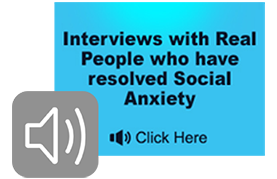It’s a secret shame, a “personal failure” C-suite executives seldom acknowledge: performance anxiety so crippling that they fantasize about an escape—changing careers, getting into an accide... Read more
Three Crucial Points for the Treatment of Adult Selective Mutism An estimated 1 in 700 children have selective mutism (speaking phobia), but adult numbers are unknown, and treatment options... Read more
Having worked with over 10,ooo individuals of all ages with social and performance anxiety since 1978, the most common statements I’ve heard have been “I don’t have anything to say” and “I d... Read more
A Dynamic Profile of The Friendship Connection Bob, age 24, worked for the county parks department in a full time job. His learning disabilities impacted his overall maturation process to th... Read more
Mikey age 7, an intellectually gifted child, never spoke in school. The school recommended speech therapy. This proved useless as the problem was selective mutism, which is a very specific f... Read more
This is a complex subject about which I can write extensively. My objective with this article is to identify, and begin to organize, mental health issues for the Selective Mutism child within academic environments.
“My child is normal at home. It’s school that’s the problem!”
When a teacher tells parents that a child doesn’t talk at school, that is often their response. They may have observed this behavior in other group settings, but most often, it’s a teacher who first makes parents aware of the problem. Some teachers may even give it a name: “selective mutism.”
Typically, well-intentioned and caring teachers try to accommodate the child’s anxiety. The last thing the teacher wants to do is create stress and discomfort—for the child, for the class, and for the teacher. Accommodation takes many forms: not putting any verbal expectations on the child, letting other students talk for the Selective Mutism sufferer, “reading the child’s mind,” anticipating the child’s needs, and responding to a child’s gestures. In some cases sign language is taught and implemented.
It’s true these “workarounds” accommodate the special needs of the Selective Mutism child; and they usually make it easier to get on with teaching the rest of the class. But, if accommodation is not integrated into a systematic methodology, the process can hinder and harm the mental health of the child by “enabling” the compulsion to avoid talking. The child learns that he or she does not have to do the thing that causes discomfort. Thus, the child does not engage the neural pathways associated with verbal communication. In fact, they detach from accessing the neural pathways. The longer “detaching” takes place the more potential for pathology homeostasis exists as the Selective Mutism profile can evolve into an “avoidant personality disorder” and other problems.
Over-accommodation increases the child’s perception and sense that the world will adapt to them. It also reinforces narcissistic (self-centered) tendencies and the avoidance-dependence syndrome that has mental health professions, in general, baffled.
As a psychotherapist specializing in avoidant behavior related to social anxiety, I have worked clinically with thousands of people of all ages whose social anxiety has caused them to avoid interacting with others—often to the point of selective mutism. This syndrome does not present a pretty picture at age 18, 28, 38, or 48 years of age. (Interviews with several such patients are available by clicking here.)
Treating Selective Mutism as Something Else
Sadly, school personnel often misinterpret Selective Mutism as another emotional problem—oppositional disorder, in which a person simply defies authority, refusing to speak, for instance, not from fear but to be defiant. This leads to personality conflicts in the classroom and usually worsens the disorder.
A horror story that comes to mind occurred when a school psychologist told an 8-year-old with Selective Mutism that he couldn’t leave her office until he spoke. The result? A “breakdown,” a lawsuit, and an erroneous conclusion on the part of the parents that mental health professionals could never be of help with their child’s problem.
When an IEP or 504 plan is in effect, many schools go the route of speech therapy for selective mutism. If there is an underlying speech disorder, this can be helpful. If not, as is most often the case, this will be ineffective. The student’s complex verbal shutdown often results in the speech therapist’s being manipulated into “enabling” behavior during the therapy session.
Nor is selective mutism autism, although there are diagnostic variables to consider that can put Selective Mutism on the autistic spectrum.
A Multilayered Disorder
Selective mutism affects sufferers in a number of ways, to different degrees. Consider the acronym FATE:
There are layers to the problem. Think of:
F = function (physiology)
A = action (behavior)
T = thinking (cognition)
E = emotion
These dynamics flow complexly within the context of the potentially “enabling” school environment as well as family structure.
The Paradox of the “Reward System”
Often the first clinical response of the school psychologist or guidance counselor is to create a reward system for talking—a technique mental health professionals typically recommend. This is often ineffective. This statement I’m sure will upset many clinicians, given that it’s currently a very commonly used strategy. But in my experience working with countless families since 1978, I have concluded that this strategy unwittingly gives the pathology (disorder) more power by focusing so much attention on the mutism in a nonproductive manner. This behavioral approach often underestimates the emotional and physiological intensity of the mutism compulsion.
It’s very important for clinical efficacy to restructure the child’s perception and belief that the adults will do “all the work”; the talking, thinking and problem solving. This is why “paradoxical” or opposite strategies are necessary.
Why “Bridging Techniques” Are Not Enough
Another common approach is the use of “bridging techniques.” These include a “buddy system,” whispering, the use of voice recorders, and more. This strategy makes sense. It’s important for this process to be organized. A developmental methodology must be in place that increases positive expectations productively and incrementally. Please do not underestimate my reference to “organized” and “methodology.” All too often, this strategy is implemented in a fragmented manner, which reaches the point of diminishing returns.
“Bridging techniques” are clinically important, but they do not resolve the core problem. Remember, Selective Mutism should be understood as obsessive-compulsive disorder, not a talking problem. There are emotional, cognitive, and physiological dynamics that need to be worked on for true healing to occur.
Integrating Therapeutic and Academic Responses
Obviously, responding to the Selective Mutism child with a therapeutic as well as academic response in the school setting can be a complex and daunting task.
My approach to integrating a therapeutic process into the school starts with the following generally described methodology. There’s much more extensive information at www.socialanxiety.com.
Teaching the parents a “team approach” to parenting.
Implementing a non-enabling methodology.
Helping the parents manage their own emotions and anxieties during the treatment process.
Training parents to help the child identify thoughts and feelings. This is called “processing.” While this is a challenging task, the therapeutic payoff can be enormous.
A core clinical issue, in my opinion, is to help the child access the neural pathways associated with verbal performance with as much confidence as is possible. This requires teaching the child to be comfortable being uncomfortable. This is an important dynamic necessary for effective treatment for all manifestations of social and performance anxiety. I have observed clearly that there is more clinical potential if this process is facilitated by parents before non-enabling strategies are implemented in school. At the right point in the treatment process, when the child’s expectations have been restructured concurrent with clinical nurturing, the child is more able to handle the stress of non-enabling in school.
Be aware that the scientific definition of “stress” is “adaptation to change.” So it is natural for the child to experience stress during the treatment process. But stress is not a dirty word. It’s imperative for the child to learn how to negotiate stress if true healing is to occur.
Unfortunately, the advice so prevalent on the Internet and elsewhere suggests these children should not be exposed to stress. But in the case of Selective Mutism, taking measures to over-accommodate the child so as to protect him or her from stress of emerging from silence at school can be counterproductive and often toxic. The Selective Mutism child needs to be exposed to stress developmentally, with support and insight.
My approach to integrating the therapeutic methodology into the school setting occurs only after the child’s expectations have been restructured and clinical nurturing has been solidly established. Otherwise, there would indeed be too much stress. Here is what I attempt to put in place to successfully integrate treatment within schools:
A basic orientation to Selective Mutism dynamics for school professionals.
A developmental empowering, non-enabling strategy.
A feedback system from the school to the parents and therapist.
The feedback system helps parents and therapist to focus on what events and behaviors need “processing.” In addition, the ongoing feedback is crucial to facilitate developmental techniques and strategies for non-enabling.
In my experience consulting with 100-plus schools, I have found that many are wonderful and open to learning and being helpful. Indeed, many teachers have had profoundly positive effects on my Selective Mutism patients when willing to participate in the team approach. Others are absolutely adamant that they will handle things their way and are closed to new strategies. One thing’s for sure: Integrating a therapeutic methodology into the school setting is a challenging task. Objective reality says there is no singular way to accomplish this. This task, more often than not, requires school personnel to get out of their own comfort zone; a process which can be stressful.
Please be clear on what may be the most important issue of all. While social anxiety is the quintessential disease of resistance to change, childhood selective mutism presents an opportunity to resolve the problem with early and productive intervention before the pathology becomes more a part of the personality and lifestyle.
If You Were Attending a Seminar About Selective Mutism
Until recently, very little information or help has been available for mental health professionals and to parents of selective mutes. But in the past couple of years, a number of seminars on selective mutism have been produced. I have studied them carefully. Most include a scholarly compilation of conceptual theory. They focus on explaining Selective Mutism, but have very little actual content based on experience geared to clinical efficacy. Would you rather begin your learning curve from that point, or base one based on front line clinical reality?
“Social Anxiety: The Untold Story”: A Revolutionary Program
“Social Anxiety: The Untold Story” is a 10-hour plus documentary and training series produced by the Andrew Kukes Foundation for Social Anxiety. It is based on my 34 years of clinical experience with thousands of patients. Although it is designed as a training program for mental health professionals (with continuing education credits available) it is also highly relevant for individuals and families dealing with selective mutism. In fact, approximately three hours of the program are dedicated specifically to selective mutism and the rest of the content is very highly applicable.
What differentiates it from other seminars on selective mutism is that it goes beyond mere theory to integrate the most evidence-based clinical success on film: Recovered selective mutism sufferers of all ages and their families talk on camera about their recovery. I humbly and genuinely challenge any therapist, organization, hospital, or university to present more evidence of successful recovery than is included in this program.
This “tip of the month” is in response to the countless inquiries I receive from well-intentioned school personnel who contact me regarding their concerns about selectively mute students. Th... Read more




